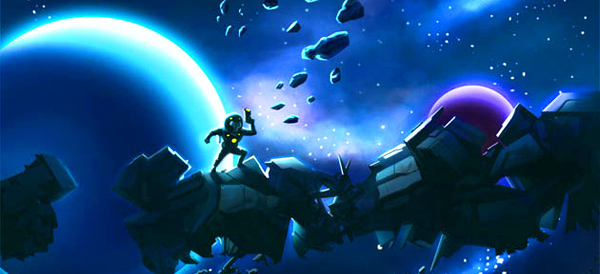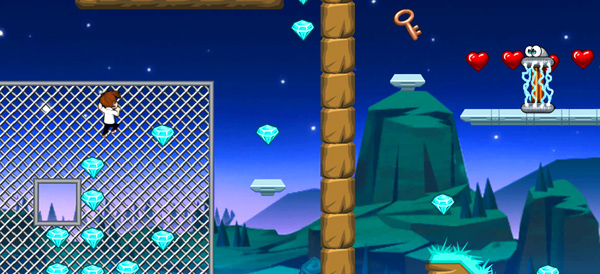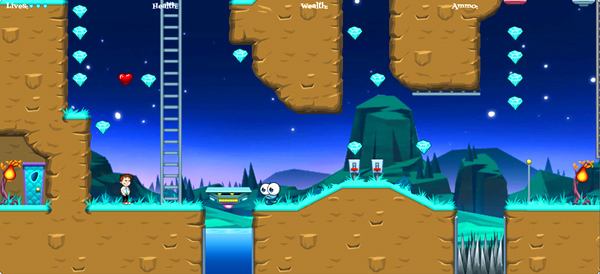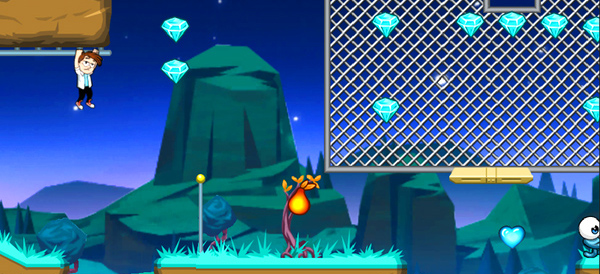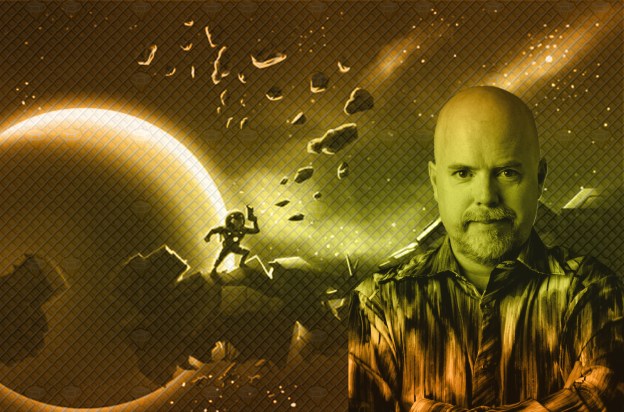
In 2013, id Software’s games endure. Doom, Quake, and Wolfenstein 3D, two decades away from their reign in the 1990s, still inform how video games get made. Those games would never have existed were it not for id’s first technological breakthrough, Commander Keen. Today it’s easy to make a great 2D platformer like Super Mario Bros. in Flash or HTML 5, but getting a PC game to support scrolling backgrounds back in 1990 wasn’t nearly as easy. Designer Tom Hall’s baby was a monumental achievement in its time.
Hall’s name may not adorn as many headlines as fellow id founders like John Romero and John Carmack, or even later id employees like American McGee, but he was instrumental in the development of some of the most important and influential video games of all time. Despite leaving id over creative differences, there may not be a Doom today without Hall. He also directed Wolfenstein 3D, which makes him one of the godfathers of the first-person shooter genre. But despite that, Hall’s first love was Commander Keen.
I wonder how many great ideas get lost because people are playing Angry Birds in the john!
Digital Trends spoke with Hall this week about returning to his roots, the challenges of crowdfunding, the future of video games, and how recovering from illness can change the creative process.
What inspired you to make Secret Spaceship Club and the Worlds of Wander project? Why return to the style of Commander Keen in 2013?
I love that style of game, and there’s a community hankering for that style. Worlds of Wander isn’t locked down to a style, other than platforming. “World Themes” will mean it can look like whatever style you wish. But I wanted to get back to the fun, quirky little sci-fi platformer, and [id Software-owner] ZeniMax was not willing to talk about selling the IP. So Secret Spaceship Club was born.

After seeing fan games pop up that worked hard to change the original graphics, and doing an overview of current tools, it seemed to me there was a need for a game creator that simplified the process down completely, but with an advanced mode once you got your feet wet. It’s time to empower people to create and share games, as easy as they can share MP3s or digital photos.
With just days left, the Worlds of Wander Kickstarter is more than $350,000 shy of its goal. What will happen to the project if it doesn’t hit the goal?
If it doesn’t fund, we’ll keep doing it as a back-burner project. But we really believe in this concept.
It’s been a year since the Kickstarter boom of resurrecting late-’80s, early-’90s game properties started with Wasteland 2, Double Fine Adventure, and others blowing up. How has crowdfunding changed the game industry? Will crowdfunding stick around?
I think it is cresting a bit, but it will stick around. A few high profile projects will get funded, and lots of little ones. It’s a great concept!
What are the inherent challenges in using public investment to make a game?
People want to see your project done before you get the money to fund doing it! And it’s a full-time job answering folks and so on. Also, conveying exactly what you see the final project looking like without having it yet!
How is your creative process different today compared to when you were working with Ion Storm fifteen years ago? Compared to working with id twenty years ago?
…Once I knew I was in the hospital and wasn’t going to die, it was fascinating.
At ION, it was creating a project for a huge team, so that means a lot of delegating. At id, it was a lot quicker. We needed an idea, I came up with one quick and we’d go forward. The first time we looked around for a matching theme was Wolfenstein 3D.
The first fifteen years of your career were spent working on cutting edge technology. The definition of cutting edge technology in video games is different now; it’s no longer about better graphics and AI, but better services and creative tools. What makes Worlds of Wander cutting edge?
The large amount of work we are doing to make it easy and “automagic” to make data. It should be as fun to edit as it is to play.
Your games have always been primarily for single players, but people seem to think that the purely solo game is going extinct. What is the future of the single-player game?
I, in no way, think the single player game will go extinct. It is true that FPS games need a multiplayer mode, but for other genres, there’s still tons of room for single-player only.
Why do people still play platformers? Why does the genre endure?
I think it’s the genre most akin to playing with toys. It allows vast exploration and achievement, and gives people a character to escape into [it] for a little while. Also 2D platforming creates limits while letting you spend your time on ideas to make the game novel. You aren’t concerned as much about the game engine and high technology as you are about ideas.

There’s an active community of Keen modders, too. So whether the young folks bond with Keen, there’s a generation that remembers him, I think.
What happened with Shaker? Are you and Brenda Brathwaite planning to revisit the project at some point?
Last we talked about it, Brenda was going to make that a paper game. An RPG is so expensive to make, it was a stretch to try a Kickstarter for it.

I understand that you had a stroke in 2010. How did your illness and recovery change you as an artist?
Well, once I knew I was in the hospital and wasn’t going to die, it was fascinating. I had a lower left pontine stroke, so it affected muscles on the right side of my body. Seeing them re-connect or re-learn was fascinating. A few days after the stroke, suddenly it was “OH! That’s how you use a spoon!” I rehabbed three times as hard as whatever they told me to do.
It taught me to do things now. I couldn’t get Keen back, so Secret Spaceship Club had to happen. I got the camera I always wanted. I am looking at the projects I want to finish and things I want to do more actively. And every birthday is awesome. I get one more!
What will video games look like in 2023?
Ten years from now, we may be moving to a data-centric world instead of a device-centric world. You own stuff, but it’s not local unless you want it to be. It will be too soon to beam images directly into the brain, but it won’t be far off. Phones may be more like the badges in Star Trek: The Next Generation. Games will be on cool bendable screens as thin as paper. All devices will have your data, your media, and your games. That’s why I want to get a head start on that idea with Worlds of Wander.
If you could make any video game, free of the constraints of technology, what would it be? Anything you can imagine.
I want to make all sorts of games, but one closer to the spirit of your question I would make is an MMO mapped to the real world. Your house is yours. People can make their own scenarios in public areas. You can visit anywhere that isn’t government-banned. You can participate in other cultures, see how good or bad it is in other cities. Re-spec your race and class and gender to see what that is like. You could experience what it’s like to live in a palace, or try to survive in a third-world country. And then time-shift to other eras and do the same. I figure that would only cost a half a billion to make well. Any takers?
